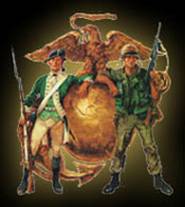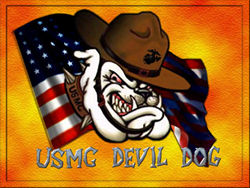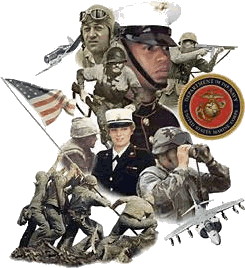



 |
 |
 |
 |
ROOTS OF THE U.S. MARINES: ANCIENT MARINES: CONFEDERATE MARINES: SEMPER FIDELIS: ONCE A MARINE, ALWAYS A MARINE: OFFICIAL BIRTHDAY OF THE USMC: General LeJeune's order summarized the history, mission, and tradition of the Marine Corps. It further directed that the order be read to all Marines on 10 November of each year to honor the founding of the Marine Corps. Thereafter, 10 November became a unique day for U.S. Marines throughout the world. Soon, some Marine commands began to not only honor the birthday, but celebrate it. In 1923 the Marine Barracks at Ft. Mifflin, Pennsylvania, staged a formal dance. The Marines at the Washington Navy Yard arranged a mock battle on the parade ground. At Quantanamo Bay, Cuba, the Marine baseball team played a Cuban team and won, 9 to 8. THE MARINE CORPS BALL: Over the years the annual Birthday Ball grew and grew, taking on a life of its own. In 1952 the Commandant, General Lemuel C. Shepherd, Jr., formalized the cake-cutting ceremony and other traditional observances. For example, Marine Corps policy now mandates that the first piece of cake must be presented to the oldest U.S. Marine present. The second piece goes to the youngest Marine. Among the many such mandates is a solemn reading of the Commandant's birthday message to the Corps. Like the U.S. Marine Corps itself, the annual Birthday Ball has evolved from simple origins to the polished and professional functions of today. Nonetheless, one thing remains constant, the tenth day of November. This unique holiday for Marine warriors is a day of camaraderie, a day to honor Corps and Country.Throughout the world on 10 November, U.S. Marines celebrate the birth of their Corps -- the most loyal, most feared, most revered, and most professional fighting force the world has ever known. There is a special aura surrounding the word "Marine." It means something different from a soldier, a cut above, and more can be expected from this person. Pride and cockiness are the trademarks of Marines, the strongest brotherhood in the world. To serve in the Marine Corps is to serve in an organization that demands and delivers excellence beyond all others. Service in the Marines leaves a lasting impression upon the innermost being of everyone who is privileged enough to serve. "Once a Marine, Always a Marine." To dispute this is to invite a brawl. Marines enjoy a reputation of prowess in battle, that was earned "in every clime and place" throughout the world in our nation's history. U.S. MARINES THE WORLD'S GREATEST WARRIORS: The truth lies in each person who wants to be a Marine. They did not just join the Marines. They must prove that they are Marines. Many have tried and failed. Only those who survive the crucible of Marine basic training, have been sculpted in mind and body into a Marine. They have become and proven they are Marines. Once they have earned the title and entered the Brotherhood of Marines, then the new warrior can draw upon the legacy of his Corps. Therein lies their strength. In return, the strength of the Corps lies in the individual Marine. The character (often defined as "what you are in the dark") of these warriors is defined by the three constant Corps Values: honor, courage, and commitment.
HONOR: COURAGE: COMMITMENT: THE THREE CORPS VALUES: U.S. MARINE MASCOT: Soon afterward a U.S. Marine recruiting poster depicted a snarling English Bulldog wearing a Marine Corps helmet. Because of the tenacity and demeanor of the breed, the image took root with both the Marines and the public. The Marines soon unofficially adopted the English Bulldog as their mascot. At the Marine base at Quantico, Virginia, the Marines obtained a registered English Bulldog, King Bulwark. In a formal ceremony on 14 October 1922, Brigadier General Smedley D. Butler signed documents enlisting the bulldog, renamed Jiggs, for the "term of life." Private Jiggs then began his official duties in the U.S. Marine Corps. A hard-charging Marine, Pvt. Jiggs did not remain a private for long. Within three months he was wearing corporal chevrons on his custom-made uniform. On New Years Day 1924, Jiggs was promoted to Sergeant. And in a meteoric rise, he got promoted again -- this time to Sergeant Major -- seven months later. SgtMaj. Jiggs' death on 9 January 1927 was mourned throughout the Corps. His satin-lined coffin lay in state in a hangar at Quantico, surrounded by flowers from hundreds of Corps admirers. He was interred with full military honors. A replacement was soon on the way. Former heavyweight boxing champion, James J. "Gene" Tunney, who had fought with the Marines in France, donated his English Bulldog. Renamed as Jiggs II, he stepped into the role of his predecessor. But there was a big problem. No discipline! Jiggs chased people, he bit people. He showed a total lack of respect for authority.The new Jiggs would have likely made an outstanding combat Marine, but barracks life did not suit him. After one of his many rampages, he died of heat exhaustion on 1928. Nonetheless, other bulldogs followed. During the 1930s, 1940s, and early 1950s they were all named Smedley, a tribute to General Smedley Butler. In the late 1950s the Marine Barracks in Washington, the oldest post in the Corps, became the new home for the Corps' mascot. Renamed Chesty to honor the legendary Lieutenant General Lewis B. "Chesty" Puller, Jr., the mascot made his first formal public appearance at the Evening Parade on 5 July 1957. In his canine Dress Blues, Chesty became an immediate media darling, a smash hit. After the demise of the original Chesty, the replacement was named Chesty II. He became an instant renegade. You name it, he did it. He even escaped and went AWOL once. Two days later he was returned in a police paddy wagon. About the only thing he ever managed to do correctly was to sire a replacement. In contrast to his father, Chesty III proved to be a model Marine. He even became a favorite of neighborhood children, for which he was awarded a Good Conduct Medal. Other bulldogs would follow Chesty III (bulldogs don't live long). When Chesty VI died after an Evening Parade, a Marine detachment in Tennessee called Washington. Their local bulldog mascot, Lance Corporal Bodacious Little, was standing by for orders to Washington. Upon arrival at the Marine Barracks in Washington, Lance Corporal Little got ceremoniously renamed Chesty VII. He and the English Bulldogs who followed him epitomize the fighting spirit of the U.S. Marines. Tough, muscular, aggressive, fearless, and often arrogant, they are the ultimate canine warriors. English Bulldogs. "Teufel-hunden." "Devil Dogs." They symbolize the ethos of the Warrior Culture of the U.S. Marines. For more info and definitions of U.S. Marine Corps terms check out the following website: USMC Dictionary. |